Current as of: April 20, 2025 - 18:25
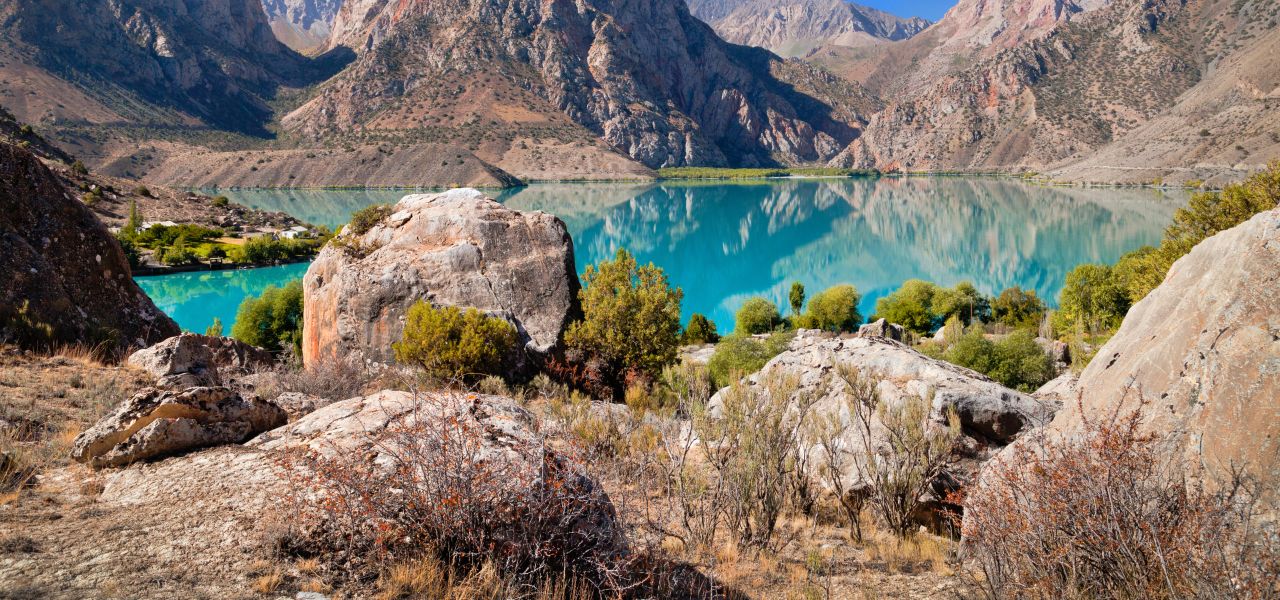
The Five Stans of the Silk Road - Reverse Trip Notes
- Ways to Travel: Guided Group
- Destination: Kazakhstan, Kyrgyzstan, Tajikistan, Turkmenistan, Uzbekistan
- Programmes: Culture
-
Activity Level:
3 out of 7 - Moderate
- 23 Days: Land Only
- Ages: 16+
- Trip Code: AXK2
- Carbon Footprint: 24kg CO2e
Trip Overview
Five countries, three weeks, one epic trip along the Silk Road through the heart of Central Asia
Vast deserts, rolling steppe, fertile valleys and majestic mountains form the backdrop to the five former Soviet republics of Central Asia, which are commonly known as the Five Stans. Among this changing and varied landscape are traditional villages, ancient towns and modern cities, which tell a tale of advancing Greek and Persian armies, marauding Mongolian hordes, traders selling wares along the Silk Road, philosophers, astronomers, Communist experiments and post-Soviet eccentrics. Journey past giant burning gas pits, intricately tiled mosques, alpine lakes bordered by yurt camps, grand monuments, rural villages and colourful markets on this epic trip through the heart of Central Asia.
About this trip: We have two versions of this trip, which have different departure dates. One starts in Ashgabat, Turkmenistan, and ends in Almaty, Kazakhstan, and the other runs in reverse. Apart from the direction of travel, the two itineraries are similar, the main difference is the route taken through Kyrgyzstan and the accommodation there.
- This itinerary (The Five Stans of the Silk Road – Reverse), which runs from Almaty, Kazakhstan, to Ashgabat, Turkmenistan, includes Chon-Kemin and Bishkek and stays in guesthouses and hotels rather than yurts.
- The Ashgabat, Turkmenistan, to Almaty, Kazakhstan, itinerary (The Five Stans of the Silk Road), includes Son Kul Lake and there are three nights staying in yurts in Kyrgyzstan.
Both itineraries include a night in a yurt in Turkmenistan.
At a Glance
- Accommodation: 21 Classic nights (18 hotels, 3 guesthouse), 1 Simple night (yurt)
- Most travel is by minibus
- Single supplement available (excludes nights in yurts)
Highlights
- Follow the footsteps of ancient traders on a journey along the Silk Road
- Witness the ‘Door to Hell’ at night, a giant burning gas pit in Turkmenistan
- Experience the life of a nomadic shepherd by sleeping in a yurt camp
- Discover the great Islamic architecture and ruins of five different countries
- Explore the villages and lakes of the Fann and Tien Shan mountains
Is This Trip for You?
This trip is rated Activity Level 3 (Moderate). For more information on our trip gradings, visit the Activity Level Guidelines page. If you have any queries about the difficulty of the trip, please contact us.
Over a relatively short period, we visit a vast array of sites, both cultural and natural, and cover five fascinating countries, which share a common history but are now developing individually. It covers a lot of distance in three weeks and there are several places where we only spend one night (especially during the section through Tajikistan and southern Kyrgyzstan).
While this is not an active trip, the pace and distance covered can be tiring. There are also some hikes, particularly in Kyrgyzstan. These are not challenging and can vary depending on the preferences and abilities of the group.
Drives: Most tend to be four to five hours’ long with the odd six-hour drive.
Comfort: Central Asia doesn’t always have great infrastructure and you shouldn’t expect the same comforts you would get at home.
- Most nights are in hotels, though we also stay in yurt camps and guesthouses, which are more basic
- Hot water is normally available, but is not always reliable
- Toilets might be squat toilets and showers may be outside the main building in the more basic accommodation
- Some nights you may have to share a room with more than one person; we make every effort to ensure men and women who are not travelling together don’t have to share a room, but this cannot be guaranteed. On these nights, single supplements do not apply. We stay in these places, however, as there are very limited options in some areas we visit
Smoking: Smoking in public is illegal in Turkmenistan (though smoking in private is fine, which means more people smoke indoors than outdoors) and you should not smoke outside the airport on arrival or in the street in Ashgabat. Also, you can only bring two packs of cigarettes into Turkmenistan.
Clothes: When visiting mosques and other religious buildings, women should wear long skirts and have their shoulders covered, we also advise bringing a scarf and covering your head on such occasions. Knee-length skirts/dresses, shorts and sleeveless tops are fine in other circumstances.
Itinerary changes: Given the bureaucracy in the region, particularly in Turkmenistan, Uzbekistan and Tajikistan, we may be forced to change the route or activities due to government decisions beyond our control.
Leaders and border crossings: As we travel through several countries, we usually have three different local tour leaders over the course of our trip. Border crossings can be chaotic and require patience. In some cases, you need to walk through a neutral zone with your luggage. A tour leader will cross the borders with the group, except the Turkmenistan/Uzbekistan border.
Group
The group is generally between five and 16 people. There is a Western leader for the duration of the tour who is supported by a different local leader in each country. Due to legal restrictions, each local leader will say farewell to you at the border and you meet the next local leader on the other side.
Adult min age: 16
Min group size: 4
Max group size: 16
Itinerary

Land Only
- Start City: Almaty
- End City: Ashgabat
Land Only Itinerary
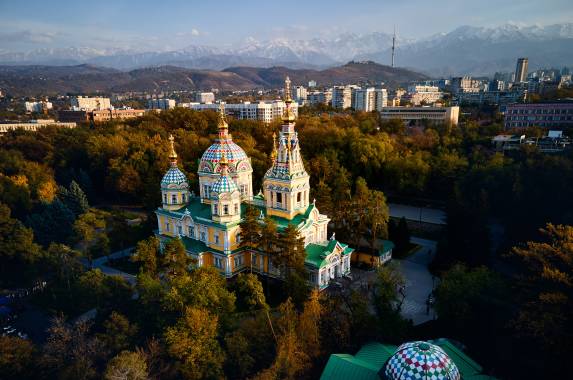
Our tour of the Five Stans starts in Almaty. The former Kazakh capital has the Tien Shan mountains as its backdrop and is the most European city in Central Asia with leafy streets and a cafe culture.
After an early check-in to our hotel, we have time for rest before lunch and setting off on a city tour around 1pm. Visit a number of sites, including Panfilovs Park, home to the Piously-Voznesenskiy Orthodox Cathedral (1907), which was built without any nails; a memorial to victims of the Second World War and the Republic Square, plus the National History Museum and the Museum of National Instruments.
Accommodation: Uyut Hotel (or similar)
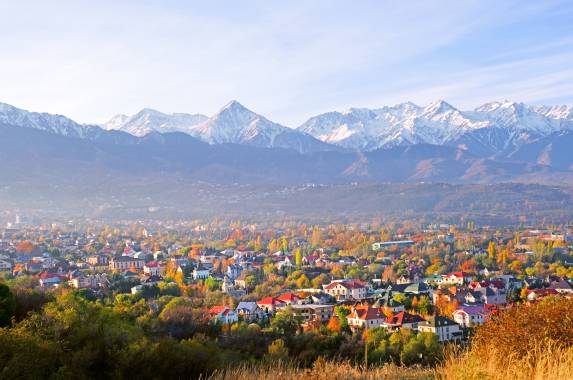
After breakfast, we transfer to Medeo Gorge, around 15mi (25km) from Almaty at 2,000m (6,560ft) above sea level, which hosts the world’s highest mountain skating rink and the largest ski resort in the region. Along the way, we stop by a well-known dam that protects the city from avalanches and mudslides, which commonly cascade from the slopes. We also take a cable car to the top to enjoy a panoramic view of the Tien Shan mountains (sometimes the cable car is closed for maintenance; when this occurs, we’re usually able to travel up to the base station by electric vehicle but not get to the top).
After, we return to Almaty and take another cable car at Kok-Tobe recreational area to the top of Kok-Tobe hill to enjoy panoramic views of Almaty and the city’s surroundings.
After returning to our hotel mid-afternoon, we have free time to relax before an early start for the next leg of our tour tomorrow.
Accommodation: Uyut Hotel (or similar)
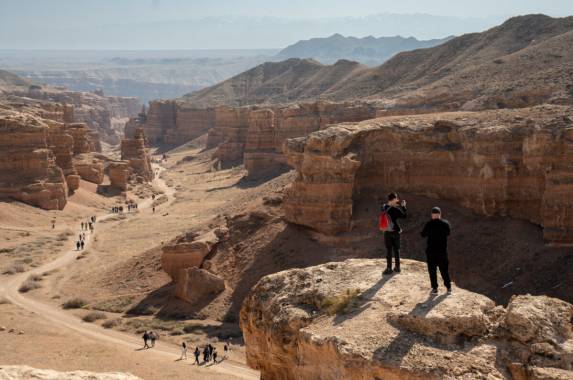
After an early start, we head to the Charyn Canyon, where dramatic erosion caused by the River Charyn has created an impressive landscape. The site is also known as the Valley of Castles with a peculiar bright-red colour and rock formations that resemble castles.
We have approximately three hours at the Charyn Canyon, there is the choice of walking 1mi (1.5km) down into the canyon (and the same back up afterwards), or an easier option is to enjoy the canyon from a viewpoint. There is time for a picnic lunch in the canyon (you can buy your picnic from a supermarket earlier in the day).
We cross the Kyrgyz-Kazakh border and, after border formalities, proceed to Karakol along the picturesque Karkara valley, famous for its mountain flowers that attract many beekeepers. After arriving in Karakol, we check into our hotel. There are about six hours of driving today.
Accommodation: Hotel Amir (or similar)
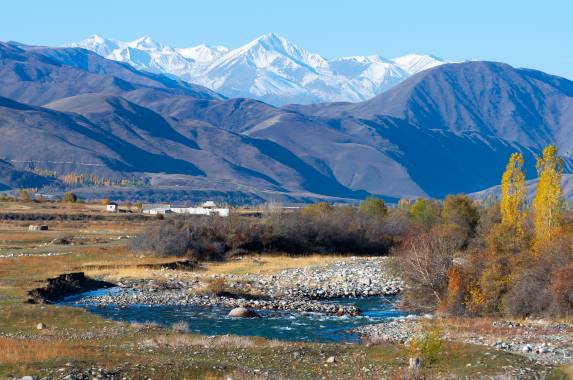
Karakol town takes us back to the times of Tsarist Russia. Our tour of the town takes in old Russian-style houses, a Russian Orthodox church dating to 1886, a wooden Dungan mosque (1899) made without nails, and Karakol bazaar.
From Karakol, we continue through the Tien Shan mountains along the northern shore of Issyk Kul Lake to the town of Cholpon-Ata. Issyk Kul is the second largest salt lake in the world, measuring 43mi by 112mi (70km by 180km) and almost 2,300ft (700m) deep. The name translates as Hot Lake, as it never freezes over, even in the depths of winter. It’s surrounded by a mixture of forest and meadow with a backdrop of mountains and glaciers. More than 100 streams and rivers flow into the lake but none flow out, which is said to be explained by the underwater tectonic activity in the lake.
We reach the resort town of Cholpon-Ata and visit nearby petroglyphs, a large open-air collection of rock carvings sometimes referred to as a Stone Garden, which covers some 104 acres (42ha) and contains a number of prehistoric stone structures. We also visit the Nomadic Civilization Museum, which exhibits the rich history and culture of the Altai nomads.
We then continue to Chon Kemin, a quiet valley of small villages and agricultural land with mountains and fir forests beyond. There are about five hours of driving today.
Accommodation: Kemin Guesthouse (or similar)
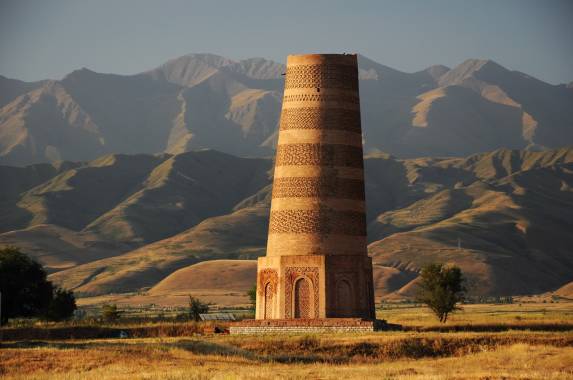
After breakfast, we head to Bishkek, the modern capital city and industrial centre of Kyrgyzstan. Along the way we stop at an 11th-century Karakhanid minaret – Burana Tower, a UNESCO World Heritage site and the first minaret of its kind in Central Asia. You can climb to the top of the tower. Take care, it’s quite dark inside and the stairs are steep and narrow. We visit the museum complex, including the tower itself, reconstructions of mausoleums found on the site, remains of a citadel, balbals (gravestones used by nomadic Turkic peoples) and petroglyphs.
After arriving in Bishkek, we check into our hotel.
Accommodation: Hotel Bridges (or similar)
Bishkek, at the foothill of the magnificent Kyrgyz Ala-Tau mountains, is a city of many green parks and marble-faced public buildings combined with numerous Soviet heritage buildings and houses. It is laid out in a grid pattern, with most streets flanked on both sides by narrow irrigation channels that water the innumerable trees. The city is believed to be the greenest in Central Asia with more trees per head of population than any other.
After breakfast, set out on a sightseeing tour that takes us to the main city sites, including the State History Museum; the Kyrgyz National Museum of Fine Arts; Ala-Too Square, the most important square in the country; and Oak Park, one of the oldest parks in Bishkek.
Accommodation: Hotel Bridges (or similar)
We have an early start today before a long but scenic drive along the spectacular Bishkek-Osh highway through the central Tien Shan mountains to Jalal-Abad. We drive through picturesque canyons and gorges and around Toktogul Reservoir with its cascade of hydroelectric power stations.
We continue over Ala-Bel (3,120m/10,235ft) and Tyua-Ashuu (3,050m/10,005ft) mountain passes, along the picturesque Suusamyr mountain valley. In summer, the valley is dotted with hundreds of yurts, and serves as a pasture for countless herds of cattle. Here, local people produce Kyrgyz national drink, kumus (fermented mare’s milk), sour cheese and butter that they sell along the road. There are about nine hours of driving today.
Accommodation: Hotel Goodnight Jalal-Abad (or similar)
We leave the city and head for Arslanbob Nature Reserve (approximately 1hr 30min drive). The village of Arslanbob is in the mountains at around 1,600m (5,250ft) – though the top and bottom of the village vary considerably in altitude – and is surrounded by an ancient walnut forest believed to be the largest in the world.
We go for a walk and picnic lunch in the surrounding countryside. The walk takes around four hours (including lunch and stops) and requires walking shoes/boots. The pace is leisurely but if anyone prefers not to join, you are free to opt out.
Afterwards, we head back to our guesthouse (approximately 1hr 30min drive) in Jalal-Abad for the night.
Accommodation: Hotel Goodnight Jalal-Abad (or similar)
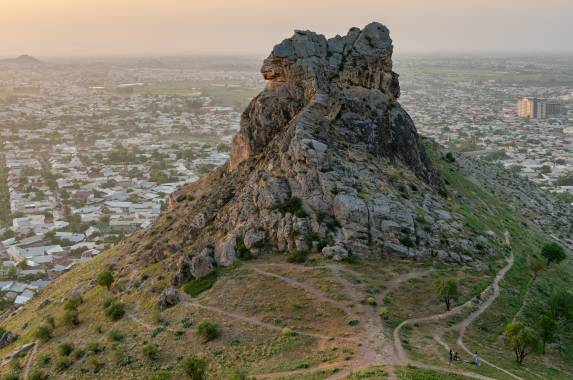
Head to Osh, Kyrgyzstan’s second largest city. Along the way, we make a sightseeing stop at Uzgen, with a history dating back over 2,000 years — it is claimed to be a site of numerous citadels built at various times since the 1st century BCE. It was an important centre of trade routes between the Fergana and the northern territories of Central Asia. Uzgen became a highly developed town in the Karakhanid’s epoch and developed into a large trading and handicraft centre. We visit an old minaret, nearby mausoleums, and a rice bazaar.
We continue to Osh and visit the sacred Sulayman Mountain, a holy Muslim site and burial place of the prophet Sulayman (Solomon), and the central point on the Silk Road. The walk to the top of Sulayman Mountain is paved with some steps and can be tiring in the heat but the views over the city and valley below, small museum and 15th-century church are worth the effort.
A short drive gets us to our next border crossing to Uzbekistan, and country number three on our tour. The crossing at the Dustlik border crossing point can take about 1hr 30min. We meet our Uzbek leader on the other side and drive for approximately two hours (62mi/100km) to Fergana town where we check into our hotel and spend the night.
Accommodation: Hotel Asia Fergana (or similar)
Transfer from Ferghana to Khujand (approximately a five-hour drive), but we make a couple of stops along the way. The first of these is at Margilan where we visit a silk factory and learn about the material which has given its name to the greatest trade route in history.
From here, continue to the small village of Rishtan, famous for potter dynasties and ceramics masters. We visit a ceramics studio and witness a demonstration of the craft before having the opportunity to buy some of the earthenware. Our final stop is Kokand, which was the capital of the 19th-century Kokand Khanate. We visit the Khudoyar-Khan Palace (1871) home to a museum, the Norbuta-Biy Madrassah and the Modarikhon Mausoleum.
From Kokand, we transfer to Uzbekistan-Tajikistan border; after border formalities, we meet our Tajik guide and drive to Khujand, where we check into our hotel.
Accommodation: Khudjand Delux Hotel (or similar)
Leaving the Fann Mountains, we head into the industrial and agricultural heartland around the city of Khujand (about four hours’ drive).
We start with a visit to Khujand. While not the most attractive of cities, it has a complex history. Believed to be one of the oldest in Central Asia, it was attacked by Alexander the Great, Arab invaders and Genghis Khan, as well as being an important Silk Road stop. There are still traces of the glory days and we take in a tour of the sites, including the Musuem of Archaeology, Sheikh Maslikhiddin Mosque, the Payshanba bazaar and, if time, Arbob Palace – the Urumkhodjaev family country estate, a copy of the Russian tsarist palace of Peterhof.
After, we transfer (five to six hours) to Penjikent via Istaravshan. The town was founded by the Persian king Kier in the sixth century, and we visit the bazaar before continuing to Penjikent for the night.
Accommodation: Panjakent Plaza Hotel (or similar)
Make a trip into the heart of the Fann Mountains. We drive (50mi/80km) to Seven Lakes (or Haf Kul in Tajik) in the Shing Valley, taking a sometimes bumpy and narrow road. The high mineral content in the water gives the lakes an unusual colour. We have time to enjoy the mountains, with a walk to Hazorchashma lake and a picnic lunch in Nofin village before driving back to Penjikent.
Accommodation: Panjakent Plaza Hotel (or similar)
In Penjikent, we set out on a tour (three to four hours) that takes us to the Museum of Rudaki (Rudaki is considered by many to be the father of Persian poetry and he was born in Penjikent) and ancient Penjikent – ruins of old Sogdian town founded in the fifth century and abandoned in the eighth century. We also explore the remains of houses, a citadel with Zoroastrian fire temples and a bazaar in the excavated ruins.
After, we drive to Sarazm, one of Central Asia’s ancient settlements, dating back 5,500 years and now a World Heritage site. Next, we travel to the Uzbek border, re-enter Uzbekistan and drive to Samarkand where we check into our hotel for the evening.
Accommodation: Malika Diyora (or similar)

Spend the day exploring Samarkand. Samarkand is steeped in history, dating back 2,500 years and impacted by Alexander the Great, Genghis Khan and Tamerlane, who made it the capital of his empire in the 14th century. Its central position on the Silk Road meant it was an important stop on the route from Istanbul to Peking (now Beijing).
At its heart is the grand Registan Square flanked by the three grand madrasahs of Ulughbeg, Sherdor and Tilya Qori. We visit the grand square and the Gur Emir Mausoleum, burial place of Tamerlane, his sons and his grandson, Ulughbek. The Ulugbek Observatory was built in 1420 by Tamerlane’s grandson who was not just a ruler but also a well-known astronomer. We move onto the oversized Bibi Khanum Mosque and Shakhi Zinda – the ‘Living King’ necropolis – with its series of mausoleums dating back to the 14th and 15th centuries.
Our final visit is to the exotic Siab Bazaar with its fresh and dried fruit and nuts and other local food produce, and a paper factory. The exact order of visits may vary.
Accommodation: Malika Diyora (or similar)
Today, we drive (four to five hours) from Samarkand to Bukhara via Gijduvan. In Gijduvan, we visit the house of a famous dynasty of pottery masters, the Narzullaevs. We continue to Bukhara and explore the Sitorai-Mohl-Hosa Palace, the summer palace of the Bukhara emirs. The interior of the palace rooms is richly decorated with magnificent paintings, stucco and wood carvings.
Accommodation: Kavsar Hotel (or similar)
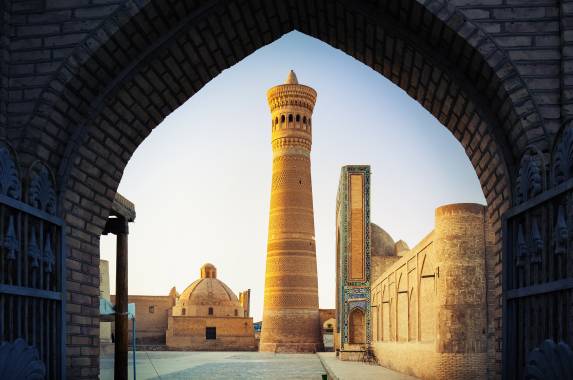
Today is spent exploring Bukhara. The best-preserved medieval city in Central Asia, this World Heritage site dates back more than 2,000 years. Our tour takes us to the Samanid Mausoleum, the oldest piece of Islamic architecture in Central Asia and burial site of the 10th-century emir; Mazar Chashma Ayub mausoleum, a sarcophagus over an ancient sacred spring; Ark Fortress, a fifth-century citadel and the oldest building in Bukhara.
Next is the Poi-Kalyan religious complex with its 48m (157ft) Kalyan minaret dating to the 12th century and the symbol of Bukhara, and the only active madrasah in the city, Bukhara Miri-Arab; the large Kalyan Mosque (15th century) with its galleries topped by 288 domes.
We then visit Lyabi Khauz complex, built in the 16th and 17th centuries, home to the oldest pool of its kind in Central Asia. The pool is surrounded by madrasahs and a khanaka (lodging house for travelling sufis), including the largest madrasah in Bukhara, the 15th-century Kukeldash Madrasah.
Accommodation: Kavsar Hotel (or similar)
This morning, we transfer (seven to eight hours) to Khiva through the Kyzylkum desert and enjoy scenic photo stops in the desert and on the banks of the Amu Darya River.
After arriving in Khiva, we check into our hotel and have the evening free to relax or explore.
Accommodation: Malika Khorezm, Khiva (or similar)
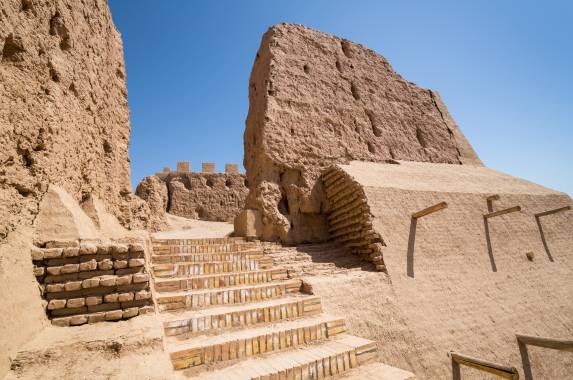
After breakfast, we head to the arid plains of Khorezm. These were once densely populated marshland, inhabited by Messagetae Scythians. These nomadic horseback archers fought to retain the land, even defeating Persian emperor Cyrus the Great in 529 BCE. We visit the 2000-year-old ruined city fortress of Toprak-Qala, which is backdropped by the Sultan Vais Mountains. The settlement began in the first century BCE under Kushan patronage and was later devastated by Turkish raids that led to the depopulation of the town in the sixth century. There are still three large round towers and an impressive portion of the citadel that still remain, but the parchments and paintings found there are now in St Petersburg’s Hermitage Museum. We also visit Qizil-Qala, formerly an important oasis with an impressive number of remaining buildings, and Ayaz-Qala, an imposing hilltop fortress dating from the sixth-century. We later return to Khiva for the night.
Accommodation: Malika Khorezm, Khiva (or similar)
After breakfast, we enjoy a walking tour of Khiva with a local guide. We visit the Ichan Kala, an open-air living museum that is the perfectly restored old city; the coloured tiled base of the never completed Kalta Minar; the 12th-century Kunya-Ark fortress, the former residence of the Khiva khans; and the beautiful mausoleum of Pakhlavan Makhmud (Khiva’s patron saint) with its tiled courtyard.
We also visit Islam Khoja minaret and madrasah (1908), the Juma mosque, which is supported by 218 wooden carved columns, Tash Khauli palaces, and Allakuli Khan. We also explore artisan workshops where we see technology behind the production of Khiva wool, silk carpets, embroidery, ceramics, and wood inlay.
After, we drive to the Shavat border post and cross into Turkmenistan where our Turkmen leader awaits. From the border, we drive to Dashoguz, the capital city of northern Turkmenistan’s Dashoguz Province, and check into our hotel.
Accommodation: Hotel Dashoguz (or similar)
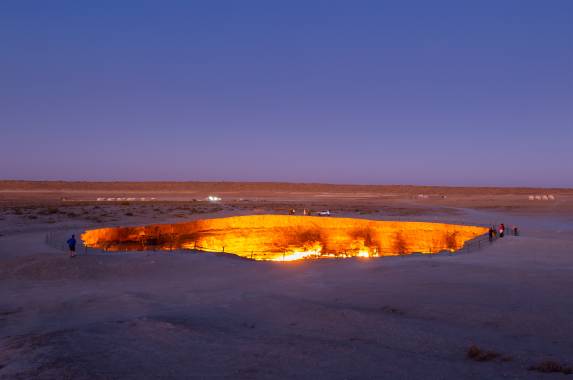
The region around Dashoguz was part of the Silk Road trade routes that connected East and West. This morning, we visit Kunya-Urgench on the left bank of the Amu Daria River (approximately 1hr 30ming drive from Dashoguz). Kunya-Urgench, also known as Old Urgench, was the capital of the Khorezm region, part of the Achaemenid Empire. The old town contains a series of monuments mainly from the 11th to 16th centuries, including a mosque, the gates of a caravanserai, fortresses, mausoleums and a 60m (200ft) high minaret. The monuments testify to outstanding achievements in architecture and craftsmanship whose influence reached Iran and Afghanistan, and later the architecture of the Mogul empire of 16th-century India.
After, we head into the Karakum Desert to a massive burning gas crater known as the Door to Hell in a remote part of the Darvaza region. In the 1970s, Soviet engineers looking for natural gas deposits came across this area. Attempting to assess the amount of gas present they set up a drill. The drill collapsed, exposing a big crater and seeping methane gas into the air. The engineers decided to set the gas alight in the belief that it would burn off within a few weeks. More than 45 years later, it is still burning. We enjoy a barbeque dinner near the crater and stay overnight in yurts very nearby. Seeing the burning crater by night is an unforgettable experience.
Accommodation: Darwaza Yurt Camp
After breakfast, we drive (four to five hours) in 4x4s to Ashgabat. We visit the National Museum of Turkmenistan and explore the ruins of the Parthian Fortress of Nisa, about a 20-minute drive away. Nisa, the former capital of the Persian Parthian Empire, controlled much of the region from Iraq to Pakistan 2,000 years ago.
Accommodation: Hotel Sport (or similar)
Ashgabat holds the record for the most white-marble buildings in the world. In the post-Soviet era, successive Turkmen leaders built these impressive buildings as a show of the country’s strength and they make for a surreal experience. Ashgabat has been described as Pyongyang meets Las Vegas, and you can see why.
We enjoy a half-day city tour, including Ertogrul Ghazi mosque, Independence Park, the Neutrality Arch, Constitution Monument, Alem Ferris Wheel, Magtymguly Monument, Halk Hakydasy Memorial Complex, and Wedding Palace, which looks over the city from a hilltop.
Accommodation: Hotel Sport (or similar)
Our adventure comes to an end in Ashgabat.
Accommodation
A selection of hotels, guest houses, and yurts
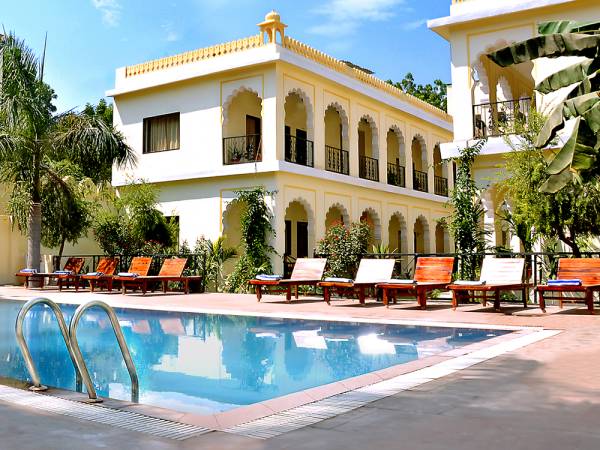
On this adventure through the Silk Road, we have 18 nights in hotels, three guesthouse nights and one night in a yurt. The accommodations typically used can be found on the day-to-day itinerary. However, below are a selection used on this trip.
Ashgabat: Sport Hotel

A four-star hotel in the heart of Ashgabat, close to the city’s major attractions. It has spacious and well-appointed rooms, plus several amenities, including a swimming pool, fitness center, sauna, and restaurant.
Bukhara: Kavsar Boutique Hotel
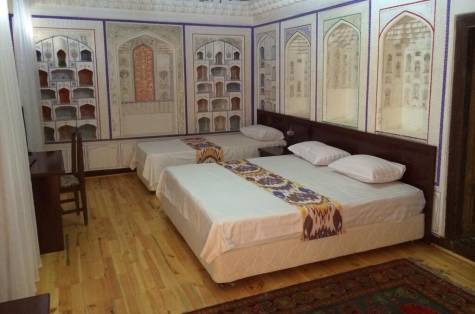
Taking over an old mansion, this small boutique hotel is one of the standout accommodations on this itinerary. It’s embellished with intricate design features and plenty of antiques, while an atmospheric central courtyard provides a wonderful place to gather as a group.
Darvaza: Yurt camp

Yurts are traditional housing for nomadic communities across Central Asia and are generally quite cosy. We spend one night in a yurt. This itinerary runs later in the year when the weather can be too cold for yurt stays in Kyrgyzstan, so we stay in hotels or guesthouses instead and follow a different route.
Almaty: Uyut Hotel
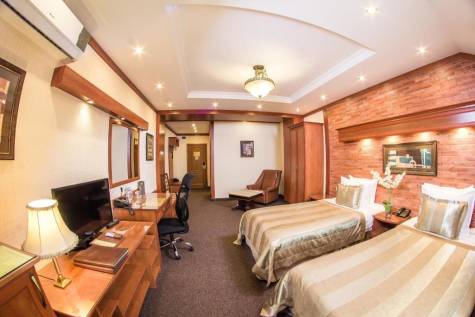
In the centre of Kazakhstan’s largest city, this modern hotel is a 25-minute drive from Almaty International Airport. It has a heated indoor pool, sauna, laundry service, bar and restaurant serving Asian, European and Eastern cuisine.
Worth knowing
- If you prefer to have your own room, a limited number of single supplements are available on a ‘first-come, first-serve’ basis on some nights of the tour – please request this at the time of booking. Please note, a single supplement is not available at the yurt camp.
- In Turkmenistan, hotels charge a daily tourist tax of around US$2 per person per day – this is included in the price for the main tour, so you needn’t worry about it. However, if you book extra nights’ accommodation in Ashgabat after the tour, you need to pay directly to the hotel yourself. If you book post-tour accommodation in Turkmenistan (and stay in the country for more than three days extra), you are required by law to register your passport with the State Service of Turkmenistan – our local partner will assist with this.
Single supplement from £ 705
Food & Drink
Common dishes in the region include shish-kebabs and plov (rice usually with mutton, onions, carrots, spices, raisins and peas). The kebabs can be from different meats, including lamb and beef, while plov is a rice-based dish (variants elsewhere are known as pilaf or pilau rice).
Another main staple is bread, especially in Uzbekistan where it is freshly baked and sold everywhere; in Turkmenistan, churek is a flat, round bread baked in clay ovens. Other traditional dishes include chorba, a meat and vegetable soup; manty, steamed dumplings filled with lamb; qu’urma, a lamb dish; ichlekli, a meat and onion pie; and gutap, a pie filled with meat, potatoes, spinach and pumpkin. There are normally a couple of opportunities to try home-cooked meals. Tea is also plentiful, both black and green, and drunk with most meals and throughout the day.
Please note, vegetarian food choices are limited. If you are vegetarian or have any special dietary requirements, please notify us well in advance. In this region, the availability of certain specialised products for restricted diets, eg gluten-free or dairy-free, is minimal or non-existent and we strongly recommend you bring such specialised dietary items from home.
Drinking water is included and where possible will be provided in large containers for you to refill your bottle from – please bring a reusable bottle with you.
Transport
The transport we use varies depending on group size and we change vehicle every country. We normally use local ‘tourist class’ minibuses/coaches. Larger groups may be split across two vehicles or in a larger bus in some countries.
Some of the drives are long but they are mostly on sealed roads with just a few sections on dirt roads, including the desert road to the burning pit at Darvaza, and heading to Son Kul Lake in Kyrgyzstan. We use SUV/4×4 vehicles for the journey to Darvaza as the last 6mi (10km) to the crater is off-road.
Weather & Seasonality
Covering a large area, from the deserts of Turkmenistan to the mountains of Kyrgyzstan, the climate varies a lot. September/October can be cooler in Tajikistan, Kyrgyzstan and Kazakhstan but more pleasant in Turkmenistan and Uzbekistan.
Later dates (ie September into October) can be particularly cold at Son Kul. You are likely to avoid the highest temperatures in Uzbekistan and Turkmenistan.
Joining Instructions
Key information
Start hotel: Uyut Hotel. Gogol St 127/1, Almaty 050000, Kazakhstan.
Phone: +7 (727) 2795111
Recommended arrival time: Before 10am on Day 1
Airport: Almaty International Airport (ALA)
Getting to the start hotel
The start hotel is approximately 35 minutes’ drive from the airport. We provide free arrival transfers to the start hotel for any flight landing on arrival day. All those taking advantage of the free airport transfers must provide full flight details for both arrival and departure in advance; unless specified otherwise, the transfer will be to the start (or pre-tour) hotel; transfers to other hotels in the same city may attract an extra charge; transfers may be shared with others on the same flight, or on a flight with similar arrival times.
Catching your return flight
There’s one group departure transfer to Ashgabat Airport (ASB). Please speak to your sales representative for times and to book your seat. If the group departure transfer does not suit your flight time, speak to your sales representative to arrange an alternative transfer at additional cost.
All arrival and departure transfers should be booked with your sales representative at least two weeks before the tour starts.
Full joining instructions including local emergency numbers will be sent to you as part of our Final Joining Instructions. If you do not receive these at least a week before departure, or require them earlier please contact our office or your travel agent.
Location start: Almaty
Location end: Ashgabat
What To Take
Essential Equipment
Due to the amount of travelling and number of border crossings, we strongly recommend you pack as light as possible and use luggage with wheels as you will have to take your own luggage through the border crossings, some of which involves walking through a neutral zone.
Items you need include:
- A photocopy or two of your passport: Our local representative will collect your passport to complete the Turkmenistan registration process
- A printed copy of your Turkmenistan LOI: You will need to hand it over to the authorities to collect your visa on arrival in Turkmenistan
- Light casual cotton clothing: it is respectful to cover your legs and arms (to the elbow) in mosques. Women should also cover their hair with a scarf when visiting holy sites. Local men tend not to wear shorts.
- Sandals are useful as they are cooler and are easier to take off when visiting mosques
- Set of thermal underwear
- Fleece, hat and gloves for cold nights
- Travel towel
- Trainers (sneakers) or walking shoes/boots
- Reusable water bottle
- Anti-diarrhoea treatment and rehydration salts
Please note, some medicines are banned in both Turkmenistan and Uzbekistan unless you are carrying a doctor’s prescription. These include medicines that contain tramadol, morphine, opiates, codeine or similar components often found in painkillers.
Water included
Plastic bottles are a big issue in many countries where recycling isn’t yet widely available; they often end up in landfill or get burned. Both processes are harmful to the environment and we would like to reduce our impact here. For your trip, we provide an alternative to single-use plastic bottles to reduce the plastic used. This means that safe drinking water will be available throughout; all you need to do is bring a bottle to refill along the way. Please add this to your packing list.
Practical Information
Visa
This trip has some specific visa and entry requirements, please read this section carefully. We strongly recommend you apply for visas at least eight weeks before the start of the trip, this includes e-visas. Visa requirements vary by nationality and are subject to change. You should reconfirm the information provided below with the relevant consulates.
PASSPORT VALIDITY
You will require at least six months validity on your passport beyond the end date of this trip.
TURKMENISTAN
We organise a letter of invitation via the State Migration Service of Turkmenistan. With this letter, a visa can be obtained on arrival at Ashgabat Airport. The State Migration Service usually issue a group letter of invitation with all participant’s personal details on. We need the following information and documents to obtain the letter of invitation:
- Last name(s) per your passport
- First and middle name(s) per your passport
- Any other name(s) used before (e.g. before marriage)
- Occupation (if retired enter “Retired”)
- Place of work (if retired just put “Not applicable”)
- Previous visits to Turkmenistan (dates, purposes)
- Marital status
- Full name, date of birth and citizenship of spouse
- Full name, date of birth and citizenship of child(ren)
- E-mail address
- Home address
Colour scan of the photo page of your passport showing all four edges of the passport. This scan must be sharp and clear and be in either JPEG or PDF format and between 250KB and 1MB.
A digital passport photo – minimum 3×4 cm. This needs to be a proper passport photo as would be used for a passport application.
Once our Turkmen partners have applied for the invitation letter it typically takes about month to be issued. We’ll usually send the letter to you shortly before the start of your tour. You need to print the letter. You will likely need to show it to board your flight to Turkmenistan. On arrival at Ashgabat Airport, you show the letter and pay the visa and administration fees.
For UK citizens, the visa fee for a visa up to 10 days is US$115 and the administration fee is US$4. For all other nationalities, the visa fee for a visa up to 10 days is US$85 and the administration fee is US$4. Payment should be made in US dollars cash.
You may be required to take a covid test on arrival. Cost is approximately US$35.
Please note that Turkmenistan has a higher visa rejection rate than most countries. This is out of our control.
Usually on the morning after your arrival, a local representative collects your passport to register your visit with the Turkmenistan State Tourist Registration Office. Your passport will be stamped and returned to you when the process is complete. During this time, you should carry a photocopy of your passport with you.
UZBEKISTAN
Travellers with a full British, Australian, or Canadian passports can enter Uzbekistan as a visitor for stays of up to 30 days without a visa. US passport holders under the age of 55 require an e-visa in advance.
If you require a visa (or e-visa) for Uzbekistan, you need a double-entry visa as we enter Uzbekistan twice.
KAZAKHSTAN
Nationals of countries including the UK, USA, Australia and Canada can enter Kazakhstan for up to 30 days without a visa.
KYRGYZSTAN
Nationals of countries including the UK, USA, Australia and Canada can enter Kazakhstan for up to 60 days without a visa.
TAJIKISTAN
Some nationalities require a visa for Tajikistan, including UK passport holders. If unsure whether you need a visa or not, check with your nearest Tajik consulate. We enter Tajikistan by land, and it is not possible to obtain a visa at land borders. Nationals of the USA, Australia and Canada do not require visas at present.
If you require a visa, we highly recommend our local operator arranges the visa on your behalf.
For UK passport holders, this has a cost of £105 which is more expensive than arranging it yourself; however, it is usually an easier and more reliable option and minimises the risk of errors. The information you need to supply us with for the Turkmenistan letter of invitation is also sufficient for the Tajikistan visa application.
If you decide to arrange your own Tajik visa
Most nationalities that require a visa can complete an online Tajikistan e-visa application: https://www.evisa.tj. The e-visa costs around US$30. Processing time varies and the process is not always straightforward. Requests are often made for extra documentation and sometimes the visa is refused without clear reason.
The e-visa type you require is ‘individual’; to the question regarding GBAO Permit, please answer ‘NO’ (this is a permit to visit a semi-autonomous region, which this trip does not visit).
There is no need to enter a Group Identifier on the e-visa application.
A letter of invitation is often requested during e-visa applications. You may receive a message from the Ministry of Foreign Affairs a few days after making your application requesting a letter. If so, please contact us and we can provide one.
Hotel details: Panjakent Plaza Hotel. 17 Prospekt Rudaki, Penjikent. 735500.
Please ensure you take a printed copy of the e-visa with you.
Take care when calculating the date of entry to Tajikistan.
You enter the Tajikistan on the 10th day of the trip. It is possible to enter Tajikistan after the valid from date of the visa but not before, so if in doubt, pick a date a couple of days earlier than your trip enters Tajikistan.
If in any doubt, please doublecheck the date of entry with our customer operations team.
If you have difficulty with the application process, the Tajik consulate in London may be able to assist: https://mfa.tj/en/london
Vaccinations and Health
Uzbekistan
There are no required vaccinations. However, you may want to consider vaccinations for tetanus, hepatitis A, hepatitis B, rabies, tuberculosis and typhoid. Please confirm with your doctor or travel clinic.
Kazakhstan
There are no required vaccinations. However, you may want to consider vaccinations for tetanus, hepatitis A, hepatitis B, rabies, tick-borne encephalitis, tuberculosis and typhoid. Please confirm with your doctor or travel clinic.
You will also require a yellow fever vaccination certificate if arriving from (or transiting through) a country with risk of yellow fever transmission.
Kyrgyzstan
There are no required vaccinations. However, you may want to consider vaccinations for tetanus, hepatitis A, hepatitis B, rabies, tuberculosis and typhoid. Please confirm with your doctor or travel clinic.
Tajikistan
There are no required vaccinations. However, you may want to consider vaccinations for polio, tetanus, hepatitis A, hepatitis B, rabies, tuberculosis and typhoid. Please confirm with your doctor or travel clinic.
Turkmenistan
Proof of vaccination against Covid-19 is required for the visa application. Additionally, you may want to consider vaccinations for tetanus, hepatitis A, hepatitis B, rabies, tuberculosis and typhoid. The risk of malaria is slight, but you may wish to consult your doctor or travel clinic for further advice.
Prohibited medicines: Some medicines are banned in countries this trip visits. This includes medicines that contain tramadol, morphine, opiates, codeine or similar components often found in painkillers. If taking medicines with you, we recommend taking a copy of your prescription with you.
Local Time
Uzbekistan's time zone: Asia/Tashkent (UTC +05:00)
Kazakhstan's time zone: Asia/Almaty (UTC +06:00)
Kyrgyzstan's time zone: Asia/Bishkek (UTC +06:00)
Tajikistan's time zone: Asia/Dushanbe (UTC +05:00)
Turkmenistan's time zone: Asia/Ashgabat (UTC +05:00)
Electricity
Uzbekistan's electricity: Plug types C (two round pins) and F (two round pins) – 220V, 50Hz
Kazakhstan's electricity: Plug types C (two round pins) and F (two round pins) – 230V, 50Hz
Kyrgyzstan's electricity: Plug types C (two round pins) and F (two round pins) – 220V, 50Hz
Tajikistan's electricity: Plug types C (two round pins) and F (two round pins) – 220V, 50Hz
Turkmenistan's electricity: Plug types C (two round pins) and F (two round pins) – 220V, 50Hz
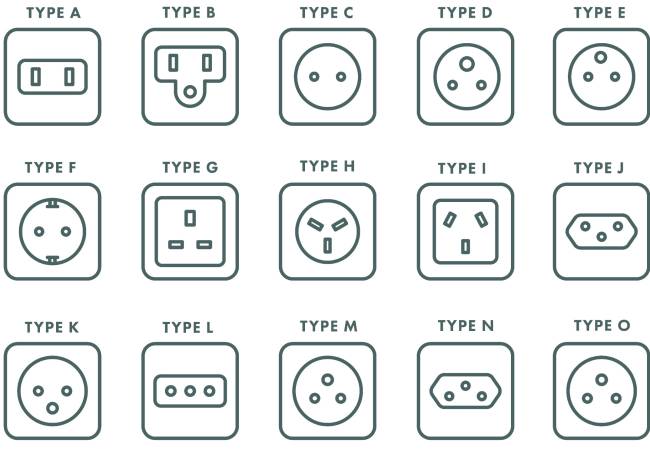
Money
Uzbekistan's currency: Uzbekistani som (UZS)
Kazakhstan's currency: Kazakhstani tenge (KZT)
Kyrgyzstan's currency: Kyrgyzstani som (KGS)
Tajikistan's currency: Tajikistani somoni (TJS)
Turkmenistan's currency: Turkmenistani manat (TMT). It is possible to exchange US dollars (clean, unmarked, undamaged, and printed on or after 1996) at banks and exchange offices; you'll find the latter at Ashgabat Airport. However, it is strictly prohibited to exchange money on the black market with individuals in bazaars, hotels etc. Please note, it is impossible to change manat back into foreign currency, so do not change too much money as you may be stuck with manat upon leaving Turkmenistan.
ATM Availability
While there are ATMs across the region, they do not always accept foreign cards in Turkmenistan, Uzbekistan and Tajikistan. There are ATMs in Kyrgyzstan and Kazakhstan, which normally work with foreign cards, but this is not always the case. You may be able to use a credit card in some gift shops, money exchange desks at large hotels, and larger shops. It is safer, however, to take most of your money in cash, especially US dollars.
Extra Expenses & Spending Money
The amount of spending money required can vary depending on how much you spend on drinks and souvenirs; as an indication, we recommend you bring at least US$300 for meals not included and a further US$150 for souvenirs, drinks and other incidentals.
Photo fees are payable at nearly all Uzbekistan sites – they vary from 5,000 to 10,000 soum (US$0.45 to US$0.90). There are also photo fees in some Turkmenistan sites, these can be up to US$14 per photo, your tour leader can advise on when this may be the case.
As a rough guideline, you should allow approximately US$8-US$10 per meal with a drink, or US$15-US$20 per person per day.
Optional Activities
There are several optional activities, which your leader can help arrange. They are subject to schedules, weather and availability; your leader will let you know what is available and the local costs. Payment should be made locally in US dollars. Below is an indication of the optional activities and their approximate costs and duration but these may vary throughout the season or depending on the number of participants and are given in good faith as a guideline only.
- Yurt construction show at Son Kul Lake: US$70 per group (one to two hours). Watch, or take part in, a demonstration of setting up a yurt with Kyrgyz nomads and learn about these dwellings.
- National horseback riding games on the shore of Son Kul Lake: US$150 per group. Chance to watch various kinds of traditional Kyrgyz horse-riding games.
- Horse-riding at Son Kul Lake: US$12 per horse for approximately two hours.
- Folklore musical show during dinner in Bishkek city: US$100 per group (20 minutes); US$150 per group (30 minutes). Professional musicians will demonstrate the traditional musical instruments and play Kyrgyz melodies.
SIM card availability:
- You have the option to purchase a SIM card for Kyrgyzstan/Uzbekistan either before your trip or upon arrival.
- If you prefer purchasing a SIM card upon arrival in Kyrgyzstan/Uzbekistan, you’ll find several options available, including at airports, convenience stores, and local network provider outlets
Tipping
Given the nature of this trip, visiting five countries, a tipping kitty is not practical; however, your tour leader will advise on whether it is possible to tip as a group. Tipping has become customary in these countries, especially for tourist activities, though this is, of course, completely at your own discretion.
As a guideline, we’d suggest planning on roughly US$5 a day for tipping. Of this, a reasonable amount would be US$2 to US$2.50 a day for each local leader and the rest split between other staff. Most of the tips would go to the local leaders and drivers but you may wish to leave a tip for hotel staff too – a tip equivalent to US$1 for a hotel porter would be a nice gesture but it is entirely up to you. Tipping of your Western leader would be appreciated but, again, is at your discretion – we suggest tipping as a group at the end of the adventure.
Sustainability and Impact
As a certified B Corp, we’re on a mission to improve our social and environmental impact across all our adventures.
We do this through our innovative Thriving Nature, Thriving People plan.
This ‘nature positive’ approach is designed to help nature and communities thrive in harmony though practical solutions, such as reducing carbon and waste on our trips, supporting conservation projects through the Exodus Adventure Travels Foundation, and rewilding 100 square metres for every Exodus traveller.
This trip goes near an area deemed unsafe to visit by the UK government’s Foreign, Commonwealth and Development Office, whose advice we follow when operating our trips. While our itinerary doesn’t go to these areas, you should familiarise yourself with your local government’s advice if you are planning any pre- or post-trip travel. Any independent travel to areas currently against your local government advice is entirely at your own risk and unlikely to be covered by your travel insurance.
Important Information
Your safe participation
When booking this trip, you should be confident in your ability to participate in all activities described in these Trip Notes. If you have any doubt about your suitability, please call us and ask to speak to one of the experts on this itinerary.
Although our leaders are well trained to deal with different capabilities, if they have any concerns about someone’s ability to safely take part in an activity, or their impact on other people’s enjoyment, we authorise them to take necessary action which, in some circumstances, may involve asking someone to miss that activity.
By booking this trip you agree to our Booking Conditions which clearly state that our leaders have the authority to do this. In these rare instances we will ensure anyone sitting out is safely provided for and offered alternative options where possible. Refunds will not be provided for activities missed and customers may be liable for additional costs incurred.
Seatbelts
All vehicles used by us should be equipped with working seatbelts, except where approved by us based on the vehicle type or journey. Wherever seatbelts are available, we require our customers to use them for their own safety, even where it may not be a legal requirement.
How to Book
- Check availability: Go online to check availability, or contact us by phone or email.
- Secure your place: You can provisionally hold a place on this trip, usually for between three and seven days.
- Complete your booking and payment
When you’re ready to book, go to our website for online bookings, book over the phone or you can complete a booking form (available online or on request by calling us). We accept all major credit and debit cards, or you can pay be cheque.
After booking
You will receive your booking confirmation letter and invoice, which includes extra information and guidance about your travel arrangements.
Full joining instructions, including local emergency numbers and details of how to reach the start point, will be sent to you approximately two to three weeks prior to departure. If you do not receive these at least a week before departure, or require them earlier, please contact our office or your travel agent.
Trip Note validity
These Trip Notes are valid from the “Current as” date on page one. They will occasionally be updated after booking and before departure; if there are any updates that significantly impact the inclusions or itinerary, customers will be written to separately. They will also receive a link to the most up-to-date Trip Notes with their Final Joining Instructions before travelling.
The information in these Trip Notes is given in good faith. Where differences exist between the Trip Notes and our current brochure or website, the Trip Notes supersede the brochure and website. All holidays can be subject to unexpected changes; to enjoy them you should be prepared to be flexible where necessary. Occasionally, it may not be possible to follow the itinerary as planned. This may be for a variety of reasons – climatic, political, physical or other. In these circumstances we will make the best-possible alternative arrangements that maintain the integrity of the original itinerary.
Licensing
Exodus is fully licensed and bonded as a tour operator. We hold Air Traffic Organisers Licence (ATOL) number 2582, issued and bonded with the Civil Aviation Authority (CAA). We are also bonded to the International Air Transport Association (IATA) and we are members of the Federation of Tour Operators (FTO) and ABTA – The Travel Association. This means you can book your Exodus holiday with confidence, as all money paid to us for your trip is fully protected.